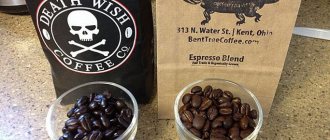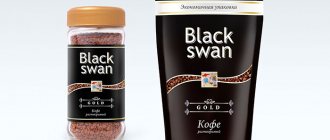15.09.2017
Coffee, especially in the morning, has long been an integral part of the lives of most people. But how did the coffee industry develop? When did coffee become more than just a drink, but a lifestyle? Let's try to figure it out.
In the morning, people can be quite easily divided into two categories: those who have already drunk coffee and those who have not yet had time. The first ones are bright-eyed, ready to work, reading the newspaper or checking emails. They walk a little faster at this early time, leaving sleep behind.
It's a different story for those who haven't had coffee yet. They sleep in transport, barely open their eyes. Books or materials they planned to repeat lie untouched on their laps. The gait is slow, and they themselves are irritable and angry if they are rushed or tried to overtake.
True, now coffee is not just an invigorating drink, but a real companion not only every morning, but also friendly meetings and dates. The coffee industry has not always been such a success; the popularity of the drink did not come immediately.
The fight against "soda" and penetration into every home
Until the late 80s of the 20th century, coffee lovers had to try hard to find high-quality or at least passable coffee.
Basically, light roasted coffee was supplied to stores in cans, most often almost tasteless. There was little to like about coffee at the time, and the industry was in decline around the world. Adding to waning consumer interest was the Brazilian frost in 1975, which caused grain prices to rise. In countries where the drink was most popular, such as the United States, people boycotted it, not wanting to pay high prices for low-quality coffee. The market became even smaller when, in the 1980s, producers realized that 20- to 29-year-olds weren't interested in coffee because they associated it with their parents. This generation preferred other soft drinks.
To survive, the coffee industry needed a new strategy. Many companies began to emphasize quality, value and image by creating segmented products. Manufacturers paid attention to why coffee deserves attention and why it should be preferred to other more ordinary drinks. This is how the specialty coffee industry was born.
The goal was to appeal to every person: the older generation who were already ardent fans of coffee, the “soda” generation, those who stopped along the way for coffee to go, and those who came to while away an extra hour. Coffee penetrated every part of people's lives and coffee lovers no longer had to complain about tasteless coffee from a can.
The movement towards specialty coffee was started by local coffee roasters overseas and in Europe. While large companies followed suit, small coffee shops were able to more easily establish trust among early specialty coffee drinkers because they were not associated with mass production and had a broader, more authentic understanding of the coffee they offered to customers. This continues to this day: coffee from the mass market does not provide the same experience that you can get by purchasing coffee from specialty coffee roasters.
Coffee culture
Türkiye
Coffee culture:
There is a famous saying in Turkey that says that “coffee should be black as hell, deadly strong and sweet as love.” This sophisticated drink is usually served after meals, hot and fresh, accompanied by a glass of water and unique Turkish sweets. Many people believe that the water served with coffee should be drunk right at the very end - to dull its taste. However, they are wrong. In fact, you should drink water before coffee so that the aftertaste from the previously eaten food does not interrupt the pleasure of this aromatic drink.
Ideal choice:
When in Turkey, you should stop at the type of coffee that is brewed best there - it, oddly enough, is called “Turkish”. Locals call it that way. This is strong black coffee, sometimes without sugar, but in most cases very sweet.
Denmark
Coffee culture:
Perhaps the reason for drinking so much coffee in Denmark is the cold and dark Scandinavian winters. In the evening, when it’s cloudy and dreary outside, you just want to sit by the fireplace with a cup of aromatic drink.
Coffee has become such an important part of Danish culture that it can be found in every store and on almost every corner, especially in large cities. Often the Danes brew a lot at once and store it in a thermos to drink all day.
Ideal choice:
In Denmark, locals are very fond of Irish coffee, which requires only regular black coffee and a little whiskey. You can find it in many cafes, and friendly owners can brew it for you right at home.
"Office" coffee
Coffee has become more accessible, and a group of 20-29-year-old young people began to drink coffee because they saw the significance in it: it has a great taste and aroma, and cheerfulness in the morning before starting the work day. But besides this, drinking coffee has a social meaning: it has become a lifestyle. The drink penetrated the mass consciousness, and its availability became ubiquitous.
Coffee machines have become a standard feature of workplaces in a changing world that demands increased productivity, focus and alertness throughout the day. In many cases, coffee for us is an integral part of performing complex tasks that require concentration. At the end of the working day, feeling tired, many of us cannot resist a cup of our favorite drink, so the queues for coffee to go in the afternoon are no less than the queues for coffee to go in the morning.
Coffee: social significance
Since the days of coffee houses in Turkey in the 14th century, the tradition of meeting for coffee has not lost its relevance. This is a manifestation of the culture of coffee consumption - we see coffee not just as a drink, but as a way of spending leisure time and meeting people. Many people come to coffee shops to read a book alone or just relax in their free time.
Coffee has become a profession, and it is not only about being a barista, which is also becoming a very popular occupation among young people, but also about coffee appraisers. There are special organizations that teach how to determine the quality of beans and their roasting, and how to choose matching combinations. After such courses, certification is carried out, and the students emerge as coffee professionals. Here we can draw a parallel with the profession of sommelier.
Coffee is a part of life, it plays a big role not only in our everyday lives, but also in the histories of different countries, in literature, cinema, but this is a topic for the next article. Coffee time!
PS During the writing of this article, I drank two cups of coffee 
How to make the healthiest drink possible
It is ideal to brew coffee in a Turk. With this method of preparation, beneficial substances are extracted from coffee beans, and there are more than 300 of them. There are several life hacks that help you get the maximum benefit from coffee.
- Before pouring water, the coffee beans need to be heated in a Turk for 15–20 seconds.
- First pour half the volume of water, then add the rest.
- Fill with water and add a pinch of sugar. It ensures the solubility of the beneficial substances contained in coffee. If this is not done, some of them will simply go to waste. But you can’t add honey. When heated, it releases a carcinogen. An alternative to sugar is salt. Through osmosis, it helps draw out some of the nutrients from the coffee beans. But for hypertensive patients it is better to refuse it. You can soften the effect of caffeine on the heart muscle with cardamom.
Subscribe to the daily email newsletter from the creators of the number 1 newspaper in Ukraine. Every evening in your inbox the most important, exclusive and useful. Subscribe .
Try our coffee
Mix of grains
Espresso coffee
Blend of 100% Arabica beans. The aroma reveals notes of roasted peanuts and hazelnuts, while the taste is dominated by dark chocolate and walnuts. Soft aftertaste of cocoa and burnt sugar.
Peru
Coffee "Chanchamayo"
Rich and strong coffee with notes of bread in the aroma.
Brazil
Coffee "Santos"
The aroma is dominated by spices and cocoa. The soft nutty-chocolate taste is offset by a slight sourness at the end.
How they drink coffee in different countries
Cuba
Coffee culture:
Cubans prefer strong coffee, and their mornings often really start with it. This drink is served there after meals, and in general at any free time. An important feature of coffee culture in Cuba is that it is served in small portions and is drunk by locals, mainly when meeting with friends or going out into the city.
Ideal choice:
Arriving in Cuba, the first thing you need to do is order real Cuban strong coffee in a small cup - you will be guaranteed unforgettable pleasure and the refined taste of the aromatic drink.
Saudi Arabia
Coffee culture:
In Saudi Arabia, as in other countries with Arabic culture, coffee ceremonies are accompanied by various rules of etiquette that must be followed in order to show respect and education. One of the rules is that you must treat your elders first. In such ceremonies, manners and respect for all those present play an important role. This sophisticated drink in Saudi Arabia is served with sweets.
Ideal choice:
In Saudi Arabia, a must-try is coffee flavored with cardamom and served with dried dates, the taste of which drowns out the bitterness of the coffee.
Dmitry Lenik, brand chef barista at Takava coffee shop
There are three official coffee waves. The first wave is characterized by the presence of black coffee in every home and on supermarket shelves. The big coffee companies developed a good marketing strategy and developed this direction until espresso appeared.
The second wave began when all drinks began to be espresso-based. And also the history of milk, when drinks with milk became popular. The third wave is characterized by the emergence of new alternative brewing methods. In addition to everything related to the preparation of espresso-based drinks, new varieties of coffee drinks began to appear, such as V60, French press, Aeropress, American press cold brew and others.
Now Ukraine is at the intersection with the fourth wave. It doesn’t exist yet, but I’m already highlighting it. It will be based on communication with guests. When the barista will tell consumers what he does, why and what product he uses.
Over the past five years, our coffee culture has begun to develop thanks to the holding of national world championships. Recently, Ukrainian baristas have been taking prizes at these events. In addition, today they have begun to invest in the development of coffee culture.
The participation of the barista in the coffee creation process also plays an important role. Previously, for example, we bought roasted beans in Italy, but now we roast them ourselves and work with fresh product. Recently, we have also started going to plantations, meeting farmers, and doing processing. Plus, new coffee shops with high-quality professional equipment are opening. And the barista profession is becoming a trend.
Visits to different countries play a direct role in development. But people are already coming to us to see what’s what.
If we talk about trendy preparations, now these are cold drinks, and everything related to cold brewing. When we prepare different drinks by infusing cold water. New combinations, different flavors, and molecular combinations are also popular, but mostly the taste of the grain itself is valued. We move from simple tasty things to more complex ones.
In Ukraine, milk drinks are most often drunk: latte has replaced cappuccino, and now the first position is occupied by flat white. Doping is no longer used in coffee shops. In second place is filter coffee, which has completely replaced Americano and manual brewing.
If you want to drink coffee at home, you can brew it using the cupping method. Take 13 grams of coffee, fill it with soft hot water at a temperature of 95 degrees - 200-250 grams. Steam for 3-4 minutes, remove the crust, wait a few more minutes and taste. Such a drink will have acidity, balance, sweetness and aftertaste. You can also make coffee at home using a French press.
Third wave
The term “Third Wave” was first coined in 2002 in an article by coffee sommelier Trish Rothgeb. In fact, we owe the very concept of coffee waves to her, since before her no one had studied the history of coffee so deeply and certainly had not classified coffee trends.
The third wave concentrates not on external attributes, but on the drink itself, its taste and character. Now the buyer knows not only the country of origin of the beans, but even the specific farm, the processing method, and the company that was involved in roasting and export. The main players in the new market are not large corporations, but small “craft” productions. People began to roast and sell coffee not so much to earn money, but to share their love for the aromatic drink with the world.
Well-known representatives: Intelligentsia Coffee & Tea, Counter Culture Coffee, Coffee Roasters.
Character traits:
- Lighter degree of roasting of beans.
- Focus on a coffee bouquet in which various nuances are felt (honey, rose petals, citrus, chocolate, nuts, etc.).
- The emergence of the art of drawing on coffee foam (Latte Art).
- Single Origin grains (not a mash blend, but grains from one farm, one harvest year).
- Absolute transparency of the origin of the coffee, right down to the name of the farmer.
- New brewing methods - French press, cold brew, etc.
- Increasing the “coffee literacy” of consumers and baristas.











